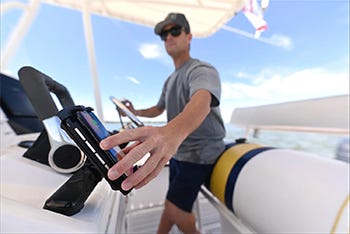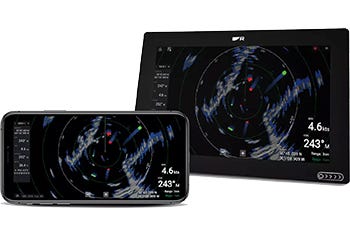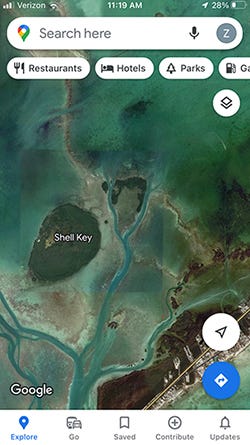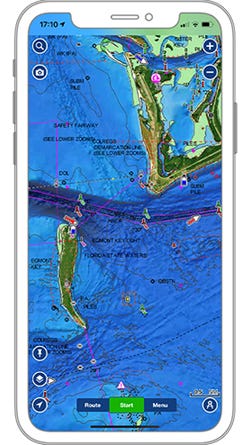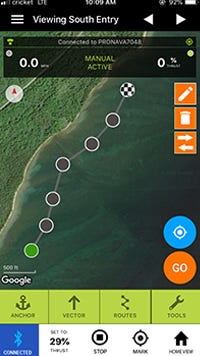

Sometimes a cigar is just a cigar, as Sigmund Freud put it, but for phones, it’s been a while since a phone was just a phone. What we call phones are actually compact computers stuffed with interfaces, needing just the right software to turn the device into whatever you need it to be. As Granpappy used to say, there’s an app for that.
Contents
The Expanding Role of Smartphones on Boats
Download an app, connect your phone to your trolling motor, and now your phone is a $1,000 trolling motor remote that’s not clipped to a belt loop and can slide off the gunnel in 200 feet of water with your digital wallet and every picture ever of your kids growing up, all at the same time. Your trolling motor remote backs up to the cloud every night, of course — right? Progress. What a time to be alive.
Well, yes, it is. If you find yourself on the water with a dead battery in that trolling motor remote, now you’ve got that app on your phone as backup. The phone was going to be onboard anyway, and the app was free. It’s up to you about going on Facebook to complain about trolling motor remote batteries before you’re even off the water. You could. It’s a free country.
Granpappy again: If you’re going to do this, do it right. Stick the phone in a holder on the console. Phone’s not going anywhere, and it’s charging too, because the holder has a built-in wireless charger. It’s streaming tunes to the stereo while you flip quickly through some apps for an update on the conditions at sea: take a peek at a wind forecaster app, pick a buoy off a map to get a live look at readings, click through to the NOAA forecast discussion for the area, then check the tide chart. If you need it to get home, there’s a GPS track on the phone, and the GPS app has maps downloaded, and works offline.
Unlimited Resources
Phones as audio head units, as miniature GPS/chartplotters, as compasses, as sources of weather and tide information, as additional screens for your main electronics, as security/tracking devices — the fact is, they can provide a lot of utility on the water. Type “boating” into your phone’s app store search. Dozens of useful hits come back.
If you’ve banned phones from your boat, fair enough. We respect that view. Even admire it. We’re weak. We’re using the phone. Might get more bang for the buck from it than anything else aboard except the outboard.
Smartphones have countless uses on board recreational boats. For instance, they can be linked to navigation and fishfinding electronics, like the Raymarine radar represented here, allowing users to interact with and control their boat’s electronics suite from anywhere.
Ready Access to Satellite Imagery
Given the depth of integration between smartphones and daily life, it’s easy to forget that this has not been going on for very long. The first smartphone hit the market in 2007. Granpappy didn’t start with that there’s an app for that thing until 2009. We’ve come a long way, baby, and fast.
The launch of Google Earth in 2005 kicked off the era of piping rich datasets via internet-connected devices full-bore into our outdoors pursuits. For the first time, we had ready access to satellite imagery (if of varying resolution) of all the places we went and wanted to go, prompting new understandings about our own backyards and becoming an indispensable tool for preparing to go someplace new.
There are implications on water as well as on land: inshore boaters and anglers can examine channels and routes, as well as shallow water habitat. Mundane stuff: click through some routes, divide the cumulative distance you got by mileage of your vessel, and you’ve got a good idea of your fuel needs for a given run.
Bringing Google Earth-level intel aboard is routine now, as long as you’ve got a few bars of cell service. In some navigation apps, you can flip between the chart view and satellite view. Pulling up satellite images of an unfamiliar flat or shoreline while you are there could be the thing that gets your boat pointed at fish today. (Somebody out there on the water just Googled “find me fish.”)
Ready access to satellite imagery like that available through Google Maps via smartphone has significantly changed inshore and freshwater fishing and navigation.
Inter/Intra
That’s about bringing the internet to your boat, mainly. You may also have something of an intranet on your boat with wired communications using ethernet protocol or wireless via Bluetooth, the short-range wireless communications standard for devices.
A couple sonar heads talking over Cat 5, front of the bass boat and back, Bluetooth remote on the trolling motor, phone runs the shallow water anchor, phone feeds the track to the GPS, which is networked to the troller, and we’re streaming a ball game to the stereo.
In addition to their own built-in functionality, smartphones can integrate with on-board equipment and accessories through an ever expanding selection of apps, like the Abyss Battery app that provides real-time data on the company’s lithium batteries..
Head Up and Charging
Boats have long lives, and if yours predates the Info Age and needs some retrofitting to join, these are among the easier of boat electronics upgrades. Minimally, you’ll want a USB port somewhere aboard and an appropriate holder for hands-free operation at the console. A mounted holder with a built-in wireless charger, waterproof and designed for marine use, is ultimate.
Third-party apps like the ProNav autopilot system for trolling motors, pictured, and apps that allow remote control of electrical equipment like bilge pumps can actually add functionality to on-board accessories.
And One Old School Thing…
It should be mentioned that anything relying on a cellular connection can be a sketchy proposition on the water, which by definition is pretty off the grid in many cases and all of the best ones.
If you have an emergency onboard, it’s sensible to try 9-1-1 on your phone first if you have any signal. But a phone is not a substitute for a two-way VHF marine radio that can get NOAA weather, which are not required on recreational boats under 65 feet but are a good safety tool to have anyway.
What Smartphones Can Do On Boats
Phones obviously have plenty of built-in functionality that can be useful for boaters and anglers — with no more than the right app, they can serve as chartplotters; compasses; still and video cameras; calculators; sources of seemingly infinite information, ranging from weather and tide predictions to local fishing regulations; and of course voice, text and email communication devices.
But you can extend your phone’s utility by taking advantage of a multitude of integrations available with other on-board equipment. Just for starters, your phone can:
- Control your trolling motor
- Control your shallow water anchor
- Control your audio system
- Control your downriggers
- Monitor and control your battery charging system
- Alert you in the event of a crew overboard situation
- Remotely monitor vessel security and vital systems like bilge pumps
- Integrate with your outboard(s) to display key data
- Integrate with your on-board chartplotter, GPS, radar and/or autopilot to serve as an additional display and interface

